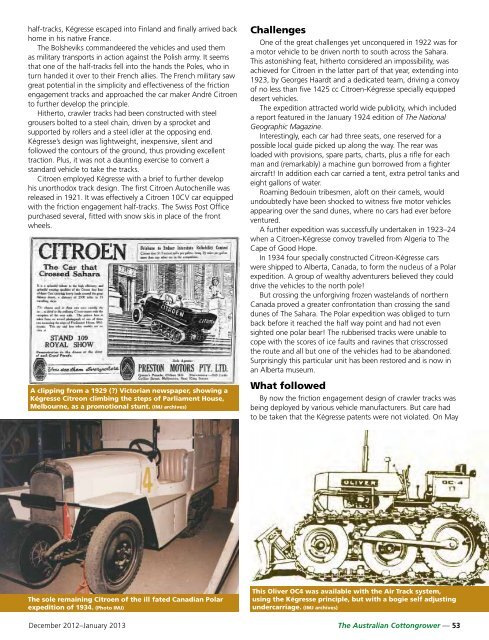cotton - Greenmount Press
cotton - Greenmount Press
cotton - Greenmount Press
You also want an ePaper? Increase the reach of your titles
YUMPU automatically turns print PDFs into web optimized ePapers that Google loves.
half-tracks, Kégresse escaped into Finland and finally arrived back<br />
home in his native France.<br />
The Bolsheviks commandeered the vehicles and used them<br />
as military transports in action against the Polish army. It seems<br />
that one of the half-tracks fell into the hands the Poles, who in<br />
turn handed it over to their French allies. The French military saw<br />
great potential in the simplicity and effectiveness of the friction<br />
engagement tracks and approached the car maker André Citroen<br />
to further develop the principle.<br />
Hitherto, crawler tracks had been constructed with steel<br />
grousers bolted to a steel chain, driven by a sprocket and<br />
supported by rollers and a steel idler at the opposing end.<br />
Kégresse’s design was lightweight, inexpensive, silent and<br />
followed the contours of the ground, thus providing excellent<br />
traction. Plus, it was not a daunting exercise to convert a<br />
standard vehicle to take the tracks.<br />
Citroen employed Kégresse with a brief to further develop<br />
his unorthodox track design. The first Citroen Autochenille was<br />
released in 1921. It was effectively a Citroen 10CV car equipped<br />
with the friction engagement half-tracks. The Swiss Post Office<br />
purchased several, fitted with snow skis in place of the front<br />
wheels.<br />
A clipping from a 1929 () Victorian newspaper, showing a<br />
Kégresse Citreon climbing the steps of Parliament House,<br />
Melbourne, as a promotional stunt. (IMJ archives)<br />
Challenges<br />
One of the great challenges yet unconquered in 1922 was for<br />
a motor vehicle to be driven north to south across the Sahara.<br />
This astonishing feat, hitherto considered an impossibility, was<br />
achieved for Citroen in the latter part of that year, extending into<br />
1923, by Georges Haardt and a dedicated team, driving a convoy<br />
of no less than five 1425 cc Citroen-Kégresse specially equipped<br />
desert vehicles.<br />
The expedition attracted world wide publicity, which included<br />
a report featured in the January 1924 edition of The National<br />
Geographic Magazine.<br />
Interestingly, each car had three seats, one reserved for a<br />
possible local guide picked up along the way. The rear was<br />
loaded with provisions, spare parts, charts, plus a rifle for each<br />
man and (remarkably) a machine gun borrowed from a fighter<br />
aircraft! In addition each car carried a tent, extra petrol tanks and<br />
eight gallons of water.<br />
Roaming Bedouin tribesmen, aloft on their camels, would<br />
undoubtedly have been shocked to witness five motor vehicles<br />
appearing over the sand dunes, where no cars had ever before<br />
ventured.<br />
A further expedition was successfully undertaken in 1923–24<br />
when a Citroen-Kégresse convoy travelled from Algeria to The<br />
Cape of Good Hope.<br />
In 1934 four specially constructed Citreon-Kégresse cars<br />
were shipped to Alberta, Canada, to form the nucleus of a Polar<br />
expedition. A group of wealthy adventurers believed they could<br />
drive the vehicles to the north pole!<br />
But crossing the unforgiving frozen wastelands of northern<br />
Canada proved a greater confrontation than crossing the sand<br />
dunes of The Sahara. The Polar expedition was obliged to turn<br />
back before it reached the half way point and had not even<br />
sighted one polar bear! The rubberised tracks were unable to<br />
cope with the scores of ice faults and ravines that crisscrossed<br />
the route and all but one of the vehicles had to be abandoned.<br />
Surprisingly this particular unit has been restored and is now in<br />
an Alberta museum.<br />
What followed<br />
By now the friction engagement design of crawler tracks was<br />
being deployed by various vehicle manufacturers. But care had<br />
to be taken that the Kégresse patents were not violated. On May<br />
The sole remaining Citroen of the ill - fated Canadian Polar<br />
expedition of 1934. (Photo IMJ)<br />
This Oliver OC4 was available with the Air - Track system,<br />
using the Kégresse principle, but with a bogie self adjusting<br />
undercarriage. (IMJ archives)<br />
December 2012–January 2013 The Australian Cottongrower — 53

















